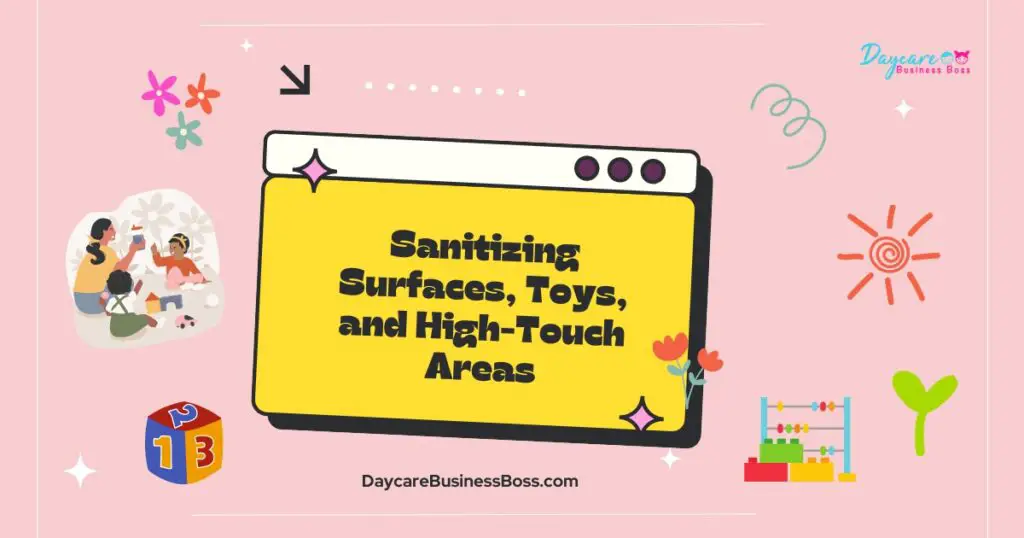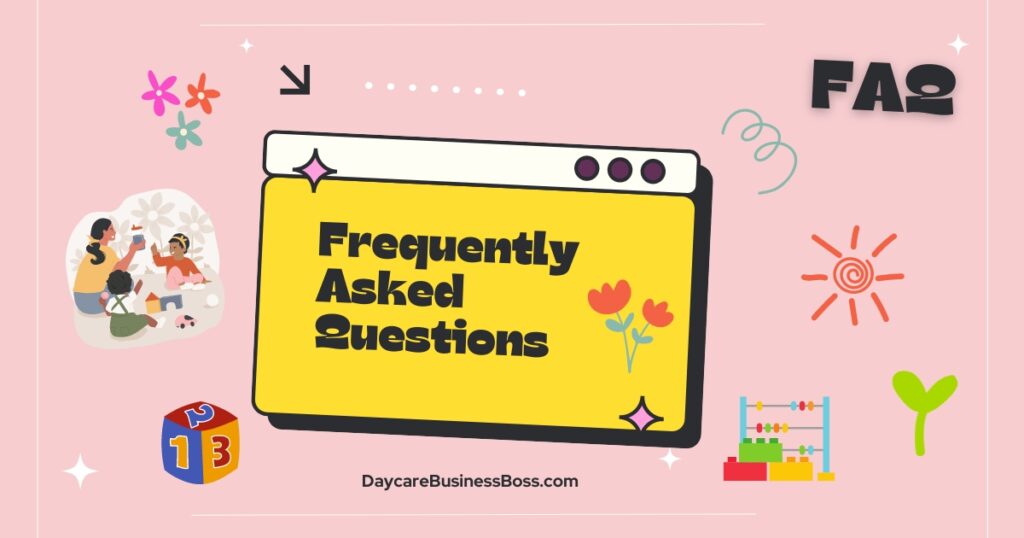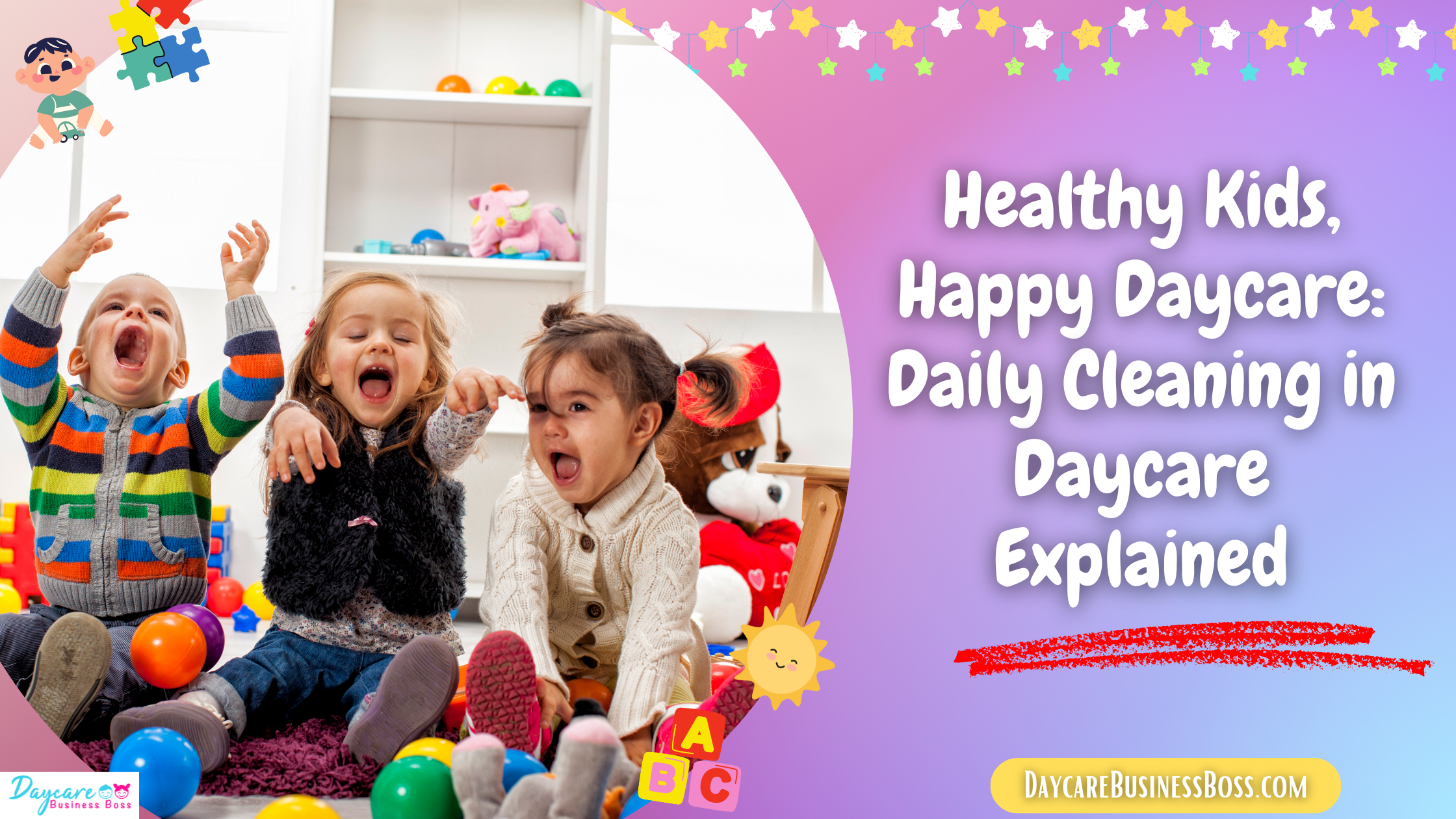Maintaining a clean and hygienic environment is critical in the hectic world of childcare centers, where children’s laughter and keen exploration fill the air. Daycare facilities are more than just childcare facilities; they are caring havens where children’s health and safety are prioritized. To do this, childcare providers must follow a detailed daily cleaning checklist that includes a variety of chores targeted at safeguarding the safety of both children and caregivers.
The best way to maintain daycare hygiene is to follow a daily cleaning routine, which includes sanitizing surfaces, toys, and high-touch areas, cleaning floors and bathrooms, disinfecting changing tables, washing bedding, emptying trash, and ensuring proper ventilation.
The Importance of Daycare Hygiene
Daycare centers play an important role in promoting children’s growth and development by providing a supportive environment that promotes learning, social interaction, and emotional development. However, this close-knit environment poses health and hygiene issues. The close closeness of children, as well as the common use of toys and facilities, might result in the transmission of germs and diseases.
Young toddlers are inherently inquisitive and eager to learn about their surroundings. They touch, feel, and manipulate objects with their hands, frequently transmitting germs from one surface to another. As a result, maintaining perfect hygiene standards in daycare centers becomes critical. To reduce the danger of infections spreading among children, regular cleaning and disinfection practices for toys, play areas, and shared facilities are needed.
Handwashing techniques are critical in reducing the spread of diseases. Encouraging youngsters to wash their hands regularly and thoroughly helps to inculcate healthy hygiene habits in them from an early age. Teaching caregivers, teachers, and staff members about the importance of cleanliness and the implementation of basic cleaning routines is critical in reducing germ transmission.
Raising parental awareness of their shared duty in keeping a healthy environment can make a substantial difference in overall daycare hygiene. Parents can be encouraged to keep their sick children at home, minimizing the likelihood of infections spreading within the daycare group.
Read more about: Going Above and Beyond: Home Visit Checklist for Family Daycare Excellence
Sanitizing Surfaces, Toys, and High-Touch Areas

A crucial activity that serves as a bulwark against germ infiltration within the scope of a daycare’s everyday operations is the rigorous sanitization of surfaces, toys, and spaces that frequently come into touch with eager small hands. These seemingly harmless surfaces serve as breeding grounds for a variety of bacteria and viruses that can endanger the health of young residents. As a result, frequent sanitization is more than just a routine activity; it is a barrier against dangerous infections.
The use of child-safe disinfectants in this thorough cleaning process is an important step toward limiting the spread of hazardous germs. Daycare providers effectively reduce the threat of contagions circulating among children by methodically targeting these bacteria. This preventive approach not only creates a safer atmosphere but also provides parents with a sense of confidence, knowing that their children are being cared for in an environment where health and well-being are prioritized.
The management of toys, which represent more than just playthings to children, is especially important. These toys are vital tools for children to explore and comprehend their surroundings. Their proclivity to be touched and even mouthed by children emphasizes the significance of regular cleaning and sanitization. Daycare centers demonstrate their commitment to maintaining the highest hygienic standards by implementing a complete routine that takes into account the special susceptibility of toys.
Clean Floors and Bathrooms
The cleanliness and upkeep of flooring and restrooms are critical in maintaining a daycare center’s thorough hygiene requirements. These seemingly insignificant details have a significant impact on the general health and well-being of young residents. Regular maintenance measures such as sweeping, mopping, and meticulous disinfection do more than just improve the visual appeal; they also serve as important barriers against contaminants.
Floor surfaces, though commonly overlooked, are breeding grounds for filth, dust, and potentially pathogenic organisms. Sweeping and cleaning ritualistically not only creates an appealing atmosphere but also efficiently eliminates these concealed hazards. A cleansed floor not only adds to the aesthetics but also helps to an environment where children can play, explore, and learn without being bothered by unsanitary components that could jeopardize their health.
Bathrooms, being high-traffic areas, demand heightened care. Their relevance extends beyond mere hygiene to the realms of comfort and wellness. Regular and thorough cleaning of bathroom fixtures, sinks, and toilets eliminates germ-breeding sites. Having a steady supply of needed toiletries provides a degree of convenience and hygiene that is critical for the children’s well-being.
Maintaining the sanctity of bathrooms goes beyond aesthetics; it is about providing a setting in which children feel safe, comfortable, and free from the threat of unsanitary circumstances. Daycare centers demonstrate a strong dedication to the health of the children in their care by adhering to these stringent cleanliness requirements. This approach not only lays the groundwork for their physical well-being but also fosters an atmosphere of dignity and general quality of life.
Disinfecting Changing Tables
Changing tables emerge as critical nexus locations of heightened concern within the intricate web of hygiene maintenance inside daycare institutions. These platforms, which are important to the diaper-changing procedure, hold both the promise of cleanliness and the risk of infection. While diapering is a vital task, it has the potential to bring viruses into the surroundings unknowingly. This emphasizes the critical need of adhering to strict disinfection measures for changing tables and their immediate surroundings.
While diaper changes may seem insignificant, they can have a significant impact on the overall hygienic landscape of the childcare center. If left neglected, the combination of moisture and organic debris creates a breeding habitat for germs. Regular disinfection creates a strong barrier against the spread of hazardous bacteria. Daycare providers efficiently limit the lifecycle of these germs by using disinfectants with care, preventing their spread and protecting the children’s health.
Incorporating the practice of sanitizing changing tables into the daily cleaning regimen is a poignant representation of the daycare’s unwavering commitment to creating a healthy and safe environment. This everyday chore goes beyond surface cleanliness; it represents the center’s dedication to the well-being of its young charges. Daycare centers demonstrate a culture that is strongly anchored in the protection of children’s health by addressing potential contamination at its source.
The act of disinfection carries tremendous symbolism. It represents a safe place for children to grow and explore without the threat of preventable diseases. It represents a dedication to nurture not only the children’s minds and souls but also their physical health. It represents a harmonious synthesis of care, commitment, and painstaking attention to detail that reverberates throughout the area, providing an inviting and safe environment.
Read more about: From Chaos to Clean: The Magic of the Free Printable Daycare Cleaning Checklist
Washing Bedding
The rhythm of a childcare center’s day frequently includes a serene intermission known as nap time, when the frenetic energy of young children dissolves into a restful slumber. The realm of bedding emerges as a major focal point requiring precise attention within this sensitive environment. Consistently washing and sanitizing bedding materials, ranging from warm sheets to soothing blankets, serves as a sentinel of a clean and relaxing sleep environment for children.
The importance of this practice extends beyond the aesthetics of neat beds. Laundry bedding regularly is a conscientious effort to maintain a standard of hygiene that benefits the children’s health and comfort. Sheets and blankets, which provide warmth and repose, can unintentionally retain dust, filth, and bacteria. Daycare facilities efficiently prevent the accumulation of toxic elements by cleaning these materials regularly, ensuring that the children are given an atmosphere conducive to good sleep and optimal well-being.
Using child-friendly detergents in the laundry process demonstrates a holistic approach to health. These specialist detergents not only clean but also help to avoid allergies and discomfort. These detergents’ delicate formulas protect youngsters from harmful irritants that could disrupt their sleep or cause bad responses.
Incorporating the practice of washing and sanitizing bedding into the routine of the daycare facility represents a comprehensive approach to care. It exhibits an understanding of the children’s individual needs and sensitivities, providing a setting in which their health and comfort come first. The culmination of these precise efforts results in more than just clean bedding; it forms a cocoon of tranquility in which children can rest, replenish, and awaken to a new realm of discovery and learning.
Emptying Trash and Waste Management
The often-overlooked aspect of waste management emerges as a cornerstone of essential practice within the complicated tapestry of childcare cleanliness. The seemingly unobtrusive garbage cans have a startling impact on the general cleanliness and health of the environment. Neglecting to empty these receptacles regularly can unwittingly create a welcoming environment for pests while encouraging the unrestrained spread of bacteria. Daycare centers, on the other hand, can foster an environment that is both spotless and free of uninvited invaders by seamlessly incorporating the routine emptying of trash into everyday operations.
When trash containers are left unattended, they attract a variety of pests. These uninvited guests not only detract from the aesthetic appeal but also pose a possible health risk by introducing disease-carrying organisms into the environment. By establishing a waste disposal procedure that is constant, daycare providers build a strong barrier against these pests, preventing their invasion and protecting the children’s health.
Frequently emptying trash cans has a secondary benefit that goes beyond just aesthetics. It creates an environment that is not only visually appealing but also free of undesirable scents. This dedication to cleanliness creates a welcoming environment in which children may study and play without interruptions or discomfort.
Waste management translates into a holistic approach to daycare well-being. Beyond the surface, it denotes a grasp of the interdependence of cleanliness and health. Conscientious trash disposal demonstrates a commitment to reducing potential health concerns and providing children with a safe refuge where they can thrive, explore, and learn without fear of avoidable hazards.
Ensuring Proper Ventilation
Ventilation is an often-overlooked partner in the complicated ballet of preserving childcare hygiene. Its relevance extends beyond simple air circulation; it has a significant impact on the purity and vibrancy of the environment. Proper ventilation is an unsung hero, efficiently reducing the concentration of airborne germs while preventing the buildup of stale air, which can cause pain and illness. Adequate ventilation acts as a silent sentinel, ensuring that the ambiance of the daycare stays invigorating and beneficial to the children’s health.
Open windows, which are sometimes regarded as just doors to the outside world, emerge as portals to fresher air within the daycare facility. Their strategic application allows for the exchange of indoor and outside air, reducing the stagnation of possibly contaminated air and bringing in a refreshing breeze. Similarly, the use of air purifiers adds another layer of filtration, eliminating particles and contaminants that could otherwise stay in the air, contributing to a cleaner and safer environment.
Monitoring in the form of regular ventilation system checks aids in maintaining the daycare’s sanitary requirements. While these systems operate tirelessly behind the scenes, they require periodic maintenance to ensure optimal functioning. Periodic inspections, cleaning, and filter changes improve the performance of these systems, resulting in a clean, breathable environment.
Proper ventilation arrangement includes a holistic approach to childcare hygiene. It is a symphony of acts that work together to create an atmosphere in which children can flourish, learn, and play without the impediment of unseen dangers. The freshness of the air, the gentle breeze that brings a promise of health, becomes a symbol of the daycare’s dedication to the children’s well-being.
Read more about: Guidelines to Grow: Licensing Your Childcare Business Effectively
Frequently Asked Questions

Why is it vital for daycare centers to have a daily cleaning routine?
A daily cleaning practice is essential in daycare centers for various reasons. Because of their developing immune systems and intimate contact, children are more vulnerable to illnesses. Sanitizing surfaces, toys, and high-touch areas, cleaning floors and bathrooms, disinfecting changing tables, washing bedding, emptying garbage, and ensuring sufficient ventilation all assist to reduce the transmission of germs and illnesses. It promotes total well-being by providing a safe and healthy environment for both children and caregivers.
How does routine disinfection of toys and high-touch areas improve daycare hygiene?
Because toddlers frequently touch and explore their environment, it is critical to disinfect toys and high-contact locations regularly. These surfaces can be home to a diverse variety of bacteria and viruses. Disinfecting toys and high-touch locations aids in the elimination of these dangerous germs, lowering the chance of infection. By adding this method to the daily cleaning routine, daycare centers provide a safer and more sanitary atmosphere that enhances children’s health and reduces the spread of infections.
How important is appropriate ventilation in daycare hygiene?
Proper ventilation is an important part of childcare hygiene that is frequently ignored. Adequate ventilation reduces the concentration of airborne pathogens and minimizes stale air buildup. It helps to keep the surroundings clean and safe for children’s activities. Proper ventilation techniques, such as opening windows, utilizing air purifiers, and maintaining ventilation systems regularly, guarantee that the daycare environment is clean, comfortable, and supportive of children’s health and well-being.
To learn more on how to start your own daycare checkout my startup documents here.
The information provided by DaycareBusinessBoss.com (“The Site”) is for general informational purposes only. All information on the Site is provided in good faith, however, we make no representation or warranty of any kind, express or implied, regarding the accuracy, adequacy, validity, reliability, availability or completeness of any information on the Site. Under no circumstance shall we have any liability to you for any loss or damage of any kind incurred as a result of the use of the Site or Reliance on any information provided on the Site. Your use of the Site and your reliance on any information on the Site is solely at your own risk.
This blog post is for educational purposes only and does not constitute legal advice. Please consult a legal expert to address your specific needs. Terms and Conditions. (https://daycarebusinessboss.com/terms-conditions/)

Meet Shawn Chun: Entrepreneur and Childcare Business Fan.
I’m a happy individual who happens to be an entrepreneur. I have owned several types of businesses in my life from a coffee shop to an import and export business to an online review business plus a few more and now I create online daycare business resources for those interested in starting new ventures. It’s demanding work but I love it. I do it for those passionate about their business and their goals. That’s why when I meet a childcare business owner, I see myself. I know how hard the struggle is to retain clients, find good employees and keep the business growing all while trying to stay competitive.
That’s why I created Daycare Business Boss: I want to help childcare business owners like you build a thriving business that brings you endless joy and supports your ideal lifestyle.

